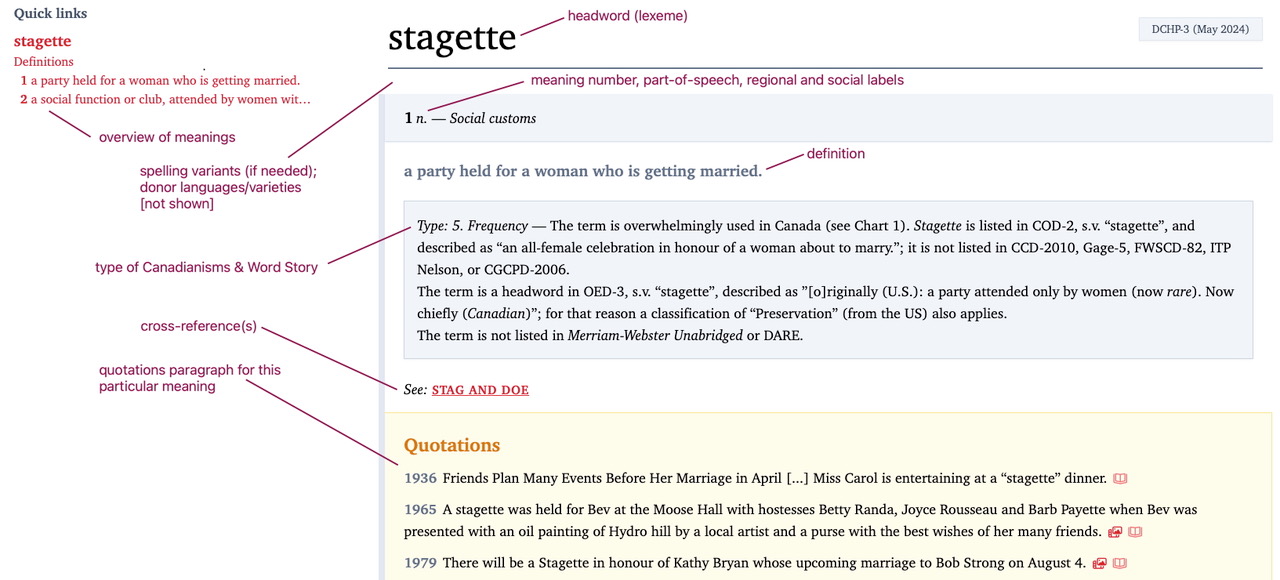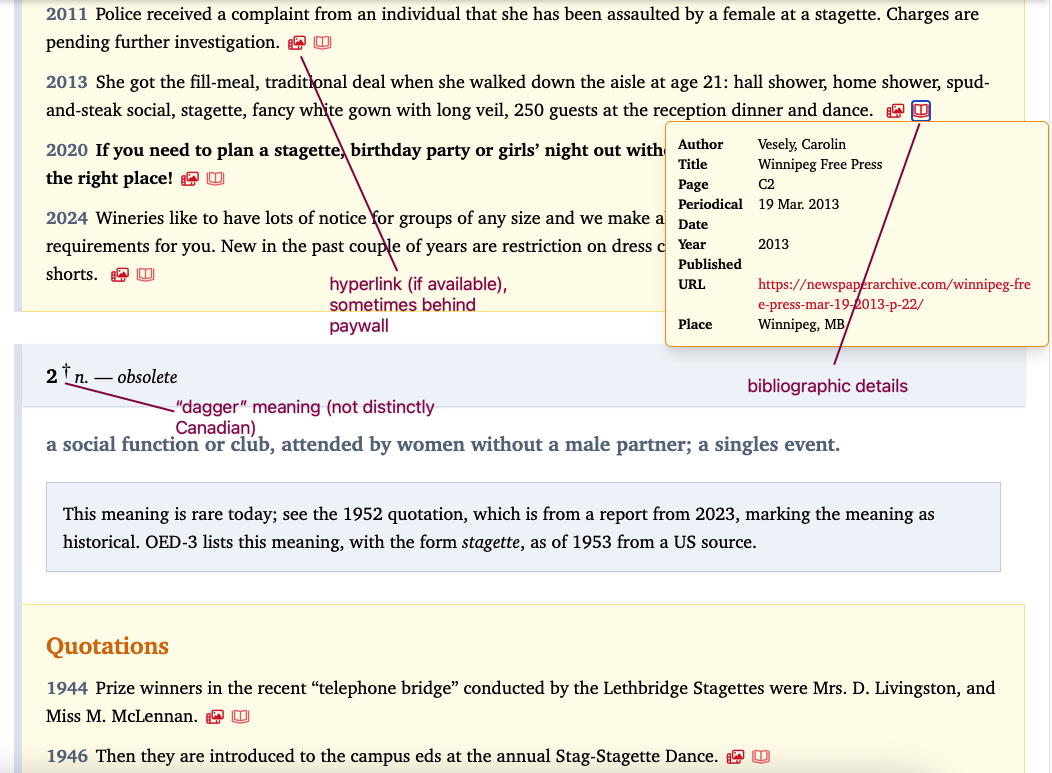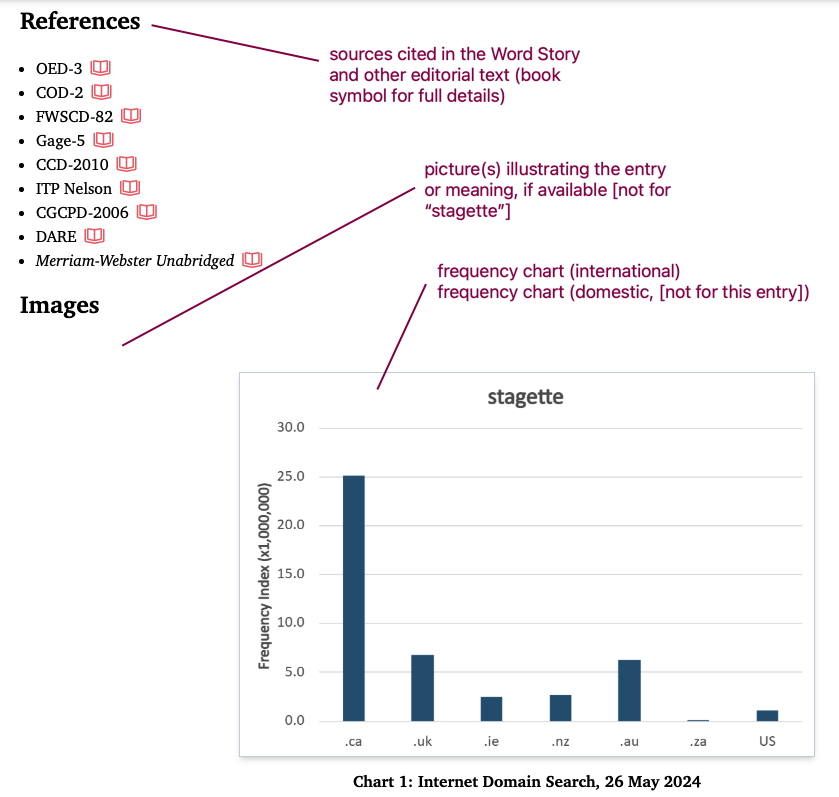How to Use DCHP-3
The basic principles of entry structure remain the same as in DCHP-2 (see here), though the appearance is quite different.
A Typology of Canadianisms
While this dictionary lists entries (headwords, lexemes), meanings are its smallest unit. Each meaning is assigned to one of six Types of Canadianism or is marked as “Non-Canadian”. The label “Non-Canadian” is used for meanings that were previously classified as Canadian or that were suspected to be Canadian but turned out to be none of our six types. The six types of Canadianisms are:
- Type 1 – Origin: a form and its meaning were created in what is now Canada
- Type 2 – Preservation: a form or meaning that was once widespread in many Englishes, but is now preserved in Canadian English in the North American context or beyond; sometimes called “retention”
- Type 3 – Semantic Change: forms that have undergone semantic change in Canadian English
- Type 4 – Culturally Significant: forms or meanings that have been enshrined in the Canadian psyche and are widely seen as part of Canadian identity
- Type 5 – Frequency: forms or meanings that are Canadian by virtue of frequency
- Type 6 – Memorial: forms or meanings now widely considered to be pejorative
- Non-Canadian: forms or meanings once thought to be Canadian for which evidence is lacking
(Dollinger 2019: 122-23)
Type 1 is a Canadianism by virtue of originating—entering the English language—in what is now Canada. A classic example is garburator; newer examples from this edition are hang a larry, hang a roger, levidrome, renovict and quinzhee. Type 2 is a preservation in Canadian English from another variety of English, often from the UK but also from the US. The standard example is pencil crayon, once used in the US and now exclusively Canadian. Newer examples are joe job, the newly reclassified parkade and peace bond.
Type 3 is assigned when semantic change has been witnessed of an older form in Canadian English, where toque ‘a chef’s hat, a woman’s hat’ was adapted to a close-fitting warm winter hat or Canuck, meaning 2b, which underwent semantic amelioration in Canada, from a term of abuse to a term of endearment for Anglophone Canadians (meaning 2a, ‘French Canadians’ did not bear such positive connotations throughout Canada’s history). New additions to this category include quadrex ‘a four-plex’, which is influenced by Quebec French and used to refer to other entities, soaker ‘a wet foot’ rather than just an alcoholic (US English)’ or social ‘wedding party’, which is common in Manitoba today.
Type 4 is the Culturally significant vocabulary, of which hockey terminology and things to do with revered Canadian institutions are prime contenders. Universal healthcare or hockey terminology, e.g. goalie mask, have that status, as do Indigenous words, e.g. culturally modified tree. This category includes those meanings of eh that are associated with Canadian English. As the country realigns itself out of Anglophone/Francophone hegemony we will see what other forms of activity will become associated with Canada. Newer terms include elbows up (meaning #2), the battle cry to avoid becoming a “51st state”, while meaning #1 is in the same category as a style of playing hockey. Other examples include poudrerie, as part of the Canadian (winter) experience, deke (n.) and deke (v.) as well as rink rat or, from local UBC student culture, bzzr ‘beer’.
Type 5 is a label that has been used often, as it is methodologically often the simplest way to establish a Canadian dimension in the comparative usage record. The classic examples are washroom ‘(public) toilet’ nationally and cube van ‘box-shaped (moving) truck’ in Central Canada. We used that criterion to declare chirp, goal suck, heat dome, klick, rig pig, substance use and quilling (meaning #2) Canadian, often in contrast to US English, in which case we insisted on a difference of several multiples of frequency in Canada compared to the US. As well, that’s how brown bread and shit disturber were assigned their Canadian labels.
Finally, Type 6 is the Memorial type. It’s the flipside of Type 4, Cultural significance, and concerns the darker aspects of Canada’s history. A prime example is residential school, the euphemism that sounds innocent but which exerted such brutal force with ongoing consequences in society today. In this edition we added maplewashing (meaning #1a) and pretendian yet we only, it seems, scratched the surface. As in DCHP-2, Type 6 - Memorial is the least developed, which would offer an approach for the next edition.
Entry Structure
The entry structure follows the established order from DCHP-2. The left margin now shows the available meanings with hyperlinks. A time stamp on the top right assigns the entry an edition (DCHP-1, DCHP-2 or DCHP-3) and adds the date, if available, when the entry was first begun.

The quotations paragraph continues for meaning #1, before meaning #2 begins. In the pictured example of stagette, meaning #2 has a “dagger”, which signifies that it is not Canadian but listed here for contextualization.

The quotations come from Canadian sources or Canadian speakers. The bibliographic details are shown with a click on the book symbol. A hyperlink to the sources is provided where available, though these sources are often behind paywalls for which users would require access, which is perhaps available through their research institutions or public libraries.
Quotations in square brackets are used for two purposes. In some cases we include non-Canadian quotations, such as the following one from 2005 from atmospheric river, which is from a US source:

In other, rather rare, cases, we provide foreign language quotations for contextualization, such as the following 2023 quotation from quadrex:

Returning to stagette, once the quotation paragraph is finished for meaning #2, the References and Images sections follow, as seen below. Any source mentioned is offered here and, where available, linked. Finally, all visuals referred to in the Word Story and other editorial texts (e.g. fist notes) are listed. First any frequency charts are listed (if available), followed by any pictures (if available).

Frequency Charts
For stagette, we show an international frequency chart.
The frequency charts follow the established model (Dollinger 2016), only this time normalized “the” was used, which has proven to be more reliable than the modal verb “could”. The precise search terms are always shown in the chart headings. Multi-part words were always searched for with quotation marks, so the chart for entry “were dinged” was created by entering:
“were dinged” site:.ca --> followed by other site searches, e.g. site:.edu
In this case, the frequency chart for ding managed to discriminate the many different meanings and isolate meaning #1, the only one with a distinct Canadian status.
Due to the polysemous nature of some terms, at times searches were narrowed by adding or excluding search terms, or by using more specialized phrases, which are reproduced in double quotation marks, such as in tick, meaning ‘credit’, with the search term “buy on tick”, or for off-reserve in the phrase “off-reserve population”, which produced a usable number of hits. Other meanings were isolated by adding Boolean search terms (AND, NOT), as can be seen in the chart for day parole, arrived at via “day parole” AND “prisoner”, or unemployment, as in she’s on unemployment, which required us to exclude the term “insurance” (hence NOT insurance). The decision to narrow a search was made by reading through the quotations and deciding whether the targeted meaning and only (or almost only) the targeted meaning had been produced. We do not explain why a certain search term combination was used and not another one, as a discussion of such methodological questions could easily take up more space than the main part of the entry.
We aimed to make the data as comparable as possible. All search dates are offered in the captions. The Frequency Index, discussed in detail in Dollinger (2016: 79-87), is the quotient of
Hits of search term/phrase divided by normalizer could * multiplier
The multiplier is always offered in the y-axis label (for stagette above it is 1,000,000). Different multipliers are used to make the charts more readable on the page, while allowing the cross-comparison across charts.
Other Charts
Our most common charts show normalized web frequency, yet occasionally we use other kinds of charts. Where meanings rather than forms are Canadian, we occasionally applied a more fine-grained analysis of a smaller sample by providing the results of a semantic analysis of unambiguous examples, such as for the term to table (legislation etc.), which can mean either ‘to postpone’ or ‘to bring forward’ for discussion. A chart showing real-time developments over a few decades is found with peace bond. Headword substance use shows an adapted frequency chart; these are found in other contexts too.
List of Labels
The labels found in DCHP-3 are offered by subject lists. Additions in DCHP-3 are in blue and concern only the semantic domain labels.
Domain labels
The domain labels were increased from 38 in DCHP-2 to 55. Note that these new labels (in blue) currently remain restricted to DCHP-3 content.
- Aboriginal (e.g. adhesion, treaty band)
- Aboriginal (Inuit) (e.g. amautik, qulliq)
- Administration (e.g. BC Day, blood donor clinic)
- Agriculture (e.g. canola, trash cover, supply management)
- Automotive (e.g. advanced green, parkade)
- Canada-US relations (e.g. Roxham Road, snowbird, maplewashing (meaning #3))
- Canadian Football (e.g. designated import, rouge ((v.)))
- Climate change (e.g. atmospheric river, heat dome, zombie fire)
- Clothing (e.g. bunny hug, Canadian tuxedo)
- Colonialism (e.g. pretendian, settler-colonial violence)
- Construction (e.g. ardox nail, wafer board)
- Curling (e.g. centre ice)
- Digital life (e.g. enshittification, ding (meaning #1))
- Economy (e.g. branch plant, corporate welfare bum)
- Education (e.g. bird course, semestering)
- Entertainment (e.g. CanCon, Brollywood)
- Ethnicities (e.g. Canadian-born Chinese, visible minority)
- Fauna (e.g. Boston bluefish, snowbird (meanings #3 & #4))
- Federalism (e.g. Roxham Road, white paper)
- Finance (e.g. ABM, download (meaning #1))
- First Nations (e.g. Bill C-31, status)
- Fishing (e.g. barge, cod moratorium)
- Flora (e.g. arbutus, partridgeberry (meanings #1a, #1b))
- Food or Food & Drink (e.g. brown cow, chocolate bar)
- Forestry (e.g. cork boot, tenas (meaning #2))
- French relations (e.g. bi and bi, tongue trooper)
- Fur trade (e.g. canot du nord, country wife)
- Games (e.g. Chinese skipping, padiddle, lahal, levidrome)
- Geography (e.g. down south, north of 60)
- Healthcare (e.g. in hospital, wait time)
- Hiphop (e.g. 6ix, T-dot)
- Hockey (e.g. muck up, Timbits (meaning #2))
- Housing (e.g. bachelor apartment, laneway house)
- Immigration (e.g. Roxham Road, landed immigrant)
- Indigenous (e.g. Indigenous identity fraud, knowledge keeper)
- Indigenous resistance (e.g. Red Paper, skoden)
- Inuit (e.g. qalunaaq, igloo)
- Industry (e.g. branch plant, Robertson screw)
- Interprovincial relations (e.g. Churchill Falls, supply management)
- Law (e.g. skill-testing question, renovict)
- Media (e.g. in hospital, caremongering)
- Military (e.g. khaki, Poppy Day)
- Mining (e.g. catskinner, rig pig)
- Outdoors (e.g. serviced, swamp donkey)
- Politics (e.g. bear-pit session, the two Michaels)
- Ranching (e.g. Texas gate, rodeo)
- Reconciliation (e.g. pretendian, Idle No More)
- Science (e.g. Standard Time, wind chill)
- Social customs (e.g. kitchen racket, May Two Four, stagette, trick or treat)
- Sports (e.g. Big O, tube skate)
- Student slang (e.g. bzzr, bird course)
- Systemic discrimination (e.g. fruit machine, Saskatoon freezing deaths)
- Trades (e.g. leadhand, rig pig)
- Transportation (e.g. seat sale, klick)
- Urban culture (e.g. substance use, off-sale)
- Weather (e.g. heat dome, poudrerie)
List of regional labels
- Alberta
- Atlantic Canada (NB, NL, NS, PE)
- British Columbia
- Cape Breton Island
- Central Canada (QC, ON)
- mainland Canada (everything but Newfoundland, the Territories, Vancouver Island)
- Manitoba
- Maritime Provinces (NB, NS, PE)
- New Brunswick
- Newfoundland
- Northern Canada
- Northwest Territories
- Nova Scotia
- Ontario
- Prairies (MB, SK, AB)
- Prince Edward Island
- Quebec
- Saskatchewan
- Territories (YT, NT, Nunavut)
- Western Canada (northwestern ON, MB, SK, AB, BC)
Social labels
- common core (= neither formal nor informal, but of the common core of Canadian English. Used sparingly, e.g. Mountie, which is the unmarked term and thus a common core term in Standard Canadian English.)
- dated
- derogatory
- diminutive
- euphemism
- humorous
- informal
- jocular
- obsolete
- offensive
- slang (incl. student slang, military slang)
Frequency labels
- also
- especially (also as “esp.”)
- near (as in “near obsolete”, etc.)
- originally
- predominantly
- rare
- rural (used sparingly) (e.g. beaver fever, skookum)
- usually
- very rare
Syntactic labels
- attributively
- in attributive position
- in figurative use
- predicative
- transitive
Copyright Note
DCHP-3 is an updated edition of DCHP-2 (Dollinger and Fee 2017). It includes content from DCHP-1, A Dictionary of Canadianisms on Historical Principles (1967 and 1991 editions, ISBN 0-7715-1976-1), edited by Avis, Walter S. (ed.-in-chief), C. Crate, P. Drysdale, D. Leechman, M.H. Scargill and C.J. Lovell, published by Gage Educational Publishing Company, a division of Canada Publishing Corporation (DCHP-1). The copyright notice of DCHP-1 can be found here. DCHP-1 was licensed to The University of British Columbia (UBC) by Nelson Education Ltd. (Nelson), the copyright owner of DCHP-1. Please see https://www.nelson.com/ for more information about Nelson. The license from Nelson allows UBC to make DCHP-3 available free of charge, as a public digital resource on the internet. However, such license does not include the reproduction, modification, editing, translation, adaptation or distribution of, or creation of derivative works based on DCHP-3 content (or parts thereof) by any person or entity. Such use of DCHP-3 content is subject to applicable copyright laws and requires express consent from the editor-in-chief (for new DCHP-3 content, i.e. entries in white and red background colours), Nelson and/or UBC (for legacy content, i.e. yellow-coloured entries).